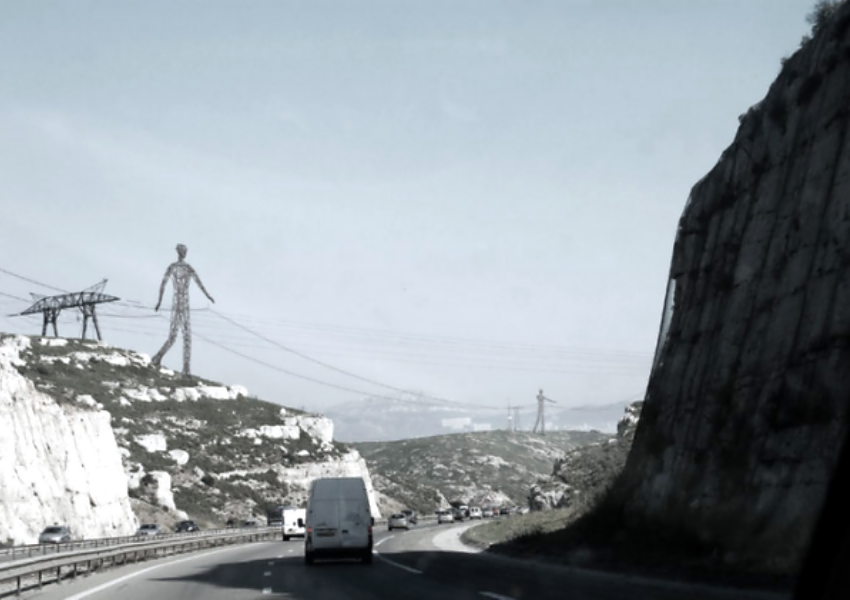 These hundred-and-fifty-foot-tall pylon figures may look like props left behind by a science fiction crew at an abandoned movie set, but can you guess the practical purpose behind them?
These hundred-and-fifty-foot-tall pylon figures may look like props left behind by a science fiction crew at an abandoned movie set, but can you guess the practical purpose behind them?
 If you noticed the lines connecting these figures, you are right: these are power lines, and the figures themselves are part of a project submitted to the High-Voltage Pylon Design Competition run in Iceland back in 2008. The competition’s goal, according to the selection committee, was to obtain new ideas in types and appearances for 220kV high-voltage towers and lines, with specific consideration given to the visual impact. The main goal of the competition was the emergence of a new type of tower, which could be developed further with respect to environmental impact, the electromagnetic field and the lifetime costs associated with the project. This was how Jin Choi & Thomas Shine of Choi+Shine Architects LCC, Massachusetts, envisioned it.
If you noticed the lines connecting these figures, you are right: these are power lines, and the figures themselves are part of a project submitted to the High-Voltage Pylon Design Competition run in Iceland back in 2008. The competition’s goal, according to the selection committee, was to obtain new ideas in types and appearances for 220kV high-voltage towers and lines, with specific consideration given to the visual impact. The main goal of the competition was the emergence of a new type of tower, which could be developed further with respect to environmental impact, the electromagnetic field and the lifetime costs associated with the project. This was how Jin Choi & Thomas Shine of Choi+Shine Architects LCC, Massachusetts, envisioned it.
 At their website Choi and Shine describe their designs as modern caryatids, “belonging to their landscape yet serving the people”, and compare them to the statues of Easter Island. Ambitious though it may sound, there hardly exists a better description for the majestic constructions that perfectly fit into the otherworldly Icelandic landscape.
At their website Choi and Shine describe their designs as modern caryatids, “belonging to their landscape yet serving the people”, and compare them to the statues of Easter Island. Ambitious though it may sound, there hardly exists a better description for the majestic constructions that perfectly fit into the otherworldly Icelandic landscape.
 Surprisingly, despite all its potential the pylon-figure project never won the competition, receiving no more than an honorable mention from the committee. Two years later it took home the award from 2010 Boston Society of Architects Unbuilt Architecture, but still the concept has never been realized. What you see right now is just a model of how Icelandic transmission towers could have looked like, if someone in the Pylon Design committee could notice “epic architecture” when it was right in front of them and waving its gigantic pylon arms.
Surprisingly, despite all its potential the pylon-figure project never won the competition, receiving no more than an honorable mention from the committee. Two years later it took home the award from 2010 Boston Society of Architects Unbuilt Architecture, but still the concept has never been realized. What you see right now is just a model of how Icelandic transmission towers could have looked like, if someone in the Pylon Design committee could notice “epic architecture” when it was right in front of them and waving its gigantic pylon arms.
 While we are on the subject of pylon arms, according to Choi and Shine, the figures can be configured to respond to their environment with appropriate gestures. As the carried electrical lines ascend a hill, the pylon-figures change posture, imitating a climbing person. Over long spans, the pylon-figure stretches to gain increased height, crouches for increased strength or strains under the weight of the wires. They can also be arranged to create a sense of place through deliberate expression. The pylon-figures can be placed in pairs, walking in the same direction or opposite directions, glancing at each other as they pass by or kneeling respectively, head bowed at a town. The possibilities are endless.
While we are on the subject of pylon arms, according to Choi and Shine, the figures can be configured to respond to their environment with appropriate gestures. As the carried electrical lines ascend a hill, the pylon-figures change posture, imitating a climbing person. Over long spans, the pylon-figure stretches to gain increased height, crouches for increased strength or strains under the weight of the wires. They can also be arranged to create a sense of place through deliberate expression. The pylon-figures can be placed in pairs, walking in the same direction or opposite directions, glancing at each other as they pass by or kneeling respectively, head bowed at a town. The possibilities are endless.
 Striking, practical and low-cost, these pylon-figures would have been a complement to every landscape, in any country on any continent. But until executives at a higher level decide to brush the dust off a years-old project they are destined to exist as mock-ups only. So let us once again bask in the awesomeness of the Land of Giants, and share it with friends – just in case someone does notice.
Striking, practical and low-cost, these pylon-figures would have been a complement to every landscape, in any country on any continent. But until executives at a higher level decide to brush the dust off a years-old project they are destined to exist as mock-ups only. So let us once again bask in the awesomeness of the Land of Giants, and share it with friends – just in case someone does notice.
